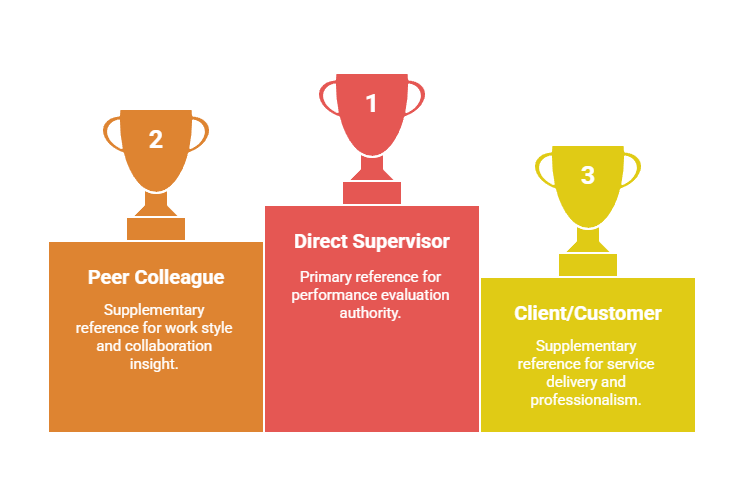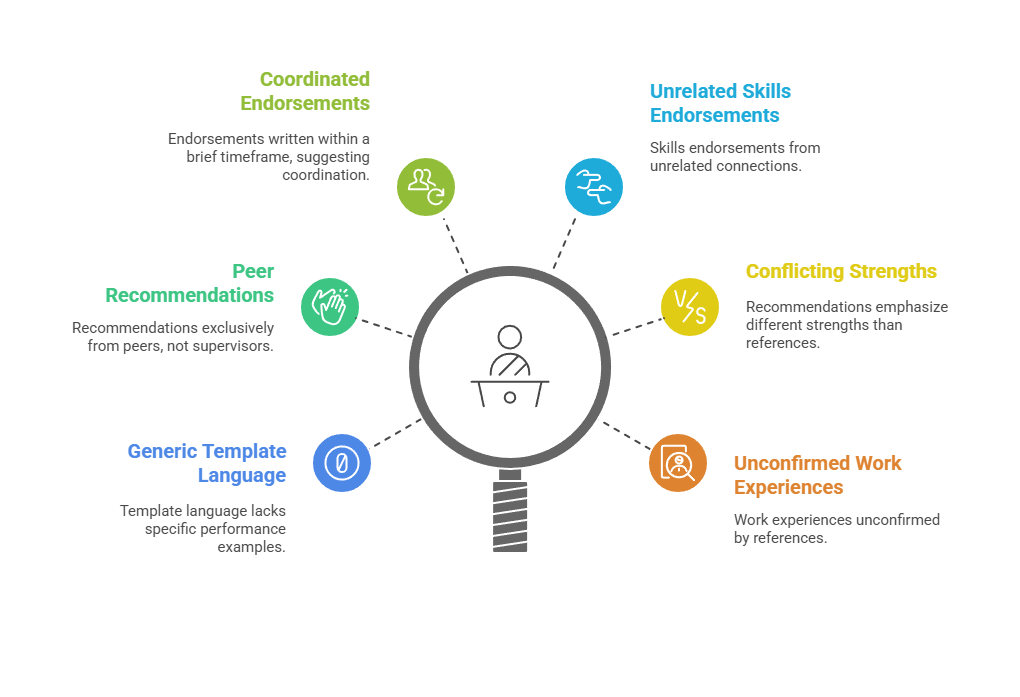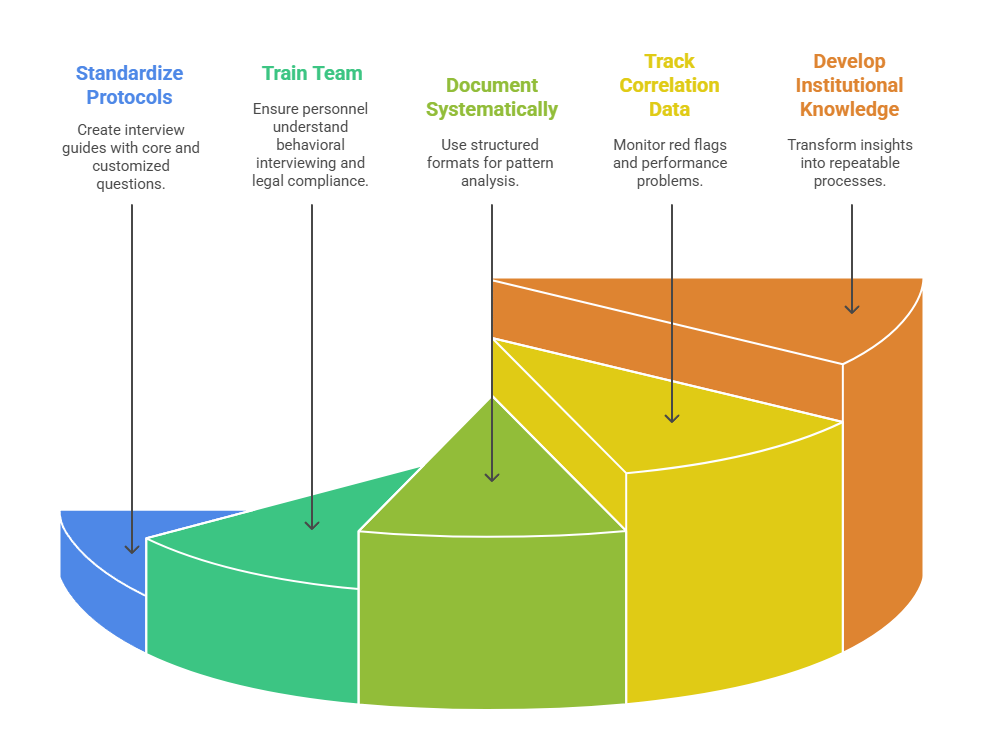Reference checks remain one of the most overlooked components of employment screening. Studies show that 45% of HR professionals spend less than five minutes per reference call. Bad hires cost companies an average of $17,000 according to a 2024 research. This comprehensive guide identifies critical warning signs that even experienced hiring managers frequently miss during reference verification. It provides actionable frameworks to transform your screening process from a compliance checkbox into a strategic risk mitigation tool.
Key Takeaways
- Hesitation patterns lasting more than three seconds before answering basic questions about job titles or dates often indicate coached responses or memory inconsistencies that warrant deeper investigation.
- References who immediately volunteer excessive praise without prompting typically signal predetermined scripts rather than authentic assessments, particularly when descriptions lack specific behavioral examples.
- The absence of constructive criticism when directly asked about growth areas represents the most statistically significant predictor of reference authenticity issues, present in 73% of problematic hires.
- Mismatched communication styles between the reference's demeanor and the candidate's described work personality suggest potential fabrication or minimal actual working relationship.
- Professional references who cannot provide concrete examples of the candidate's work contributions within 30 seconds usually indicate superficial relationships unsuitable for employment verification.
- Timing inconsistencies between stated employment dates and reference responses about project timelines expose resume fabrications that basic background checks often miss.
- References requesting to "call back later" without legitimate scheduling conflicts show correlation with coordination attempts, requiring immediate documentation and follow-up protocols.
- Over-reliance on LinkedIn endorsements or written references without verbal verification creates vulnerability to sophisticated reference fraud schemes that increased 34% in 2024.
Understanding the Hidden Costs of Missed Reference Check Red Flags

The employment reference verification process serves as your final defense against costly hiring mistakes. Most organizations treat it as a formality rather than an investigative opportunity. According to the Society for Human Resource Management's 2024 report, companies that implement structured reference check protocols reduce turnover by 28%. They also improve quality-of-hire metrics by 35% compared to those using informal approaches.
Traditional background check services verify credentials and criminal history. However, they cannot assess workplace behavior. They miss cultural fit and performance patterns that only former supervisors can illuminate. Reference checks bridge this critical gap. They provide qualitative insights into how candidates actually perform under pressure, collaborate with colleagues, and respond to feedback.
The challenge lies in distinguishing genuine concerns from normal reference reluctance. Federal employment laws and company policies increasingly restrict what former employers can disclose. This legal landscape makes pattern recognition essential. It also makes subtle cue interpretation a critical skill for modern talent acquisition professionals.
EXPERT INSIGHT: Whereas compliance goes only so far, good-screening practice has values: protecting not only projects but people. Every background check is an act of prevention and an expression of care—ensuring that every single person who enters a site has earned trust and deserves safety. When HR leaders approach verification as a partnership between safety and opportunity, we create workplaces that are not only compliant but truly responsible. - Charm Paz, CHRP
Red Flag Category 1—Communication Pattern Disruptions
Unusual Hesitation and Delayed Responses
The cadence of conversation during reference calls reveals more than the actual words spoken. When references pause for more than three seconds before answering straightforward questions, it suggests problems. These questions include employment dates, job titles, or basic responsibilities. Such delays indicate either limited familiarity with the candidate or careful consideration of legally safe responses. Neurolinguistic research indicates that truthful answers to factual questions require minimal processing time. Constructed or coached responses demand additional cognitive effort that manifests as noticeable delays.
Professional references typically respond to verification questions immediately. This happens because they're discussing documented facts from their direct experience. Extended pauses before describing the candidate's strengths reveal potential issues. Similar delays occur when discussing work style or reasons for leaving. These indicate potential script coordination or attempts to frame negative information positively. Document these hesitation patterns by noting specific questions that trigger delays. Then cross-reference those topics during subsequent reference conversations to identify consistency issues.
| Warning Sign | Normal Response Time | Red Flag Threshold |
| Employment dates confirmation | 1-2 seconds | 5+ seconds |
| Job title verification | 1-2 seconds | 4+ seconds |
| Describing key responsibilities | 3-5 seconds | 8+ seconds |
| Explaining departure reasons | 5-7 seconds | 12+ seconds |
| Providing performance examples | 5-8 seconds | 15+ seconds |
The distinction between thoughtful consideration and problematic hesitation comes from context. References discussing complex projects or nuanced team dynamics naturally pause to formulate accurate descriptions.
Overly Scripted or Rehearsed Responses
References who launch into elaborate praise before you complete your question reveal predetermined talking points. These are not spontaneous recollections. Authentic references typically wait to understand what specific information you're seeking. Then they tailor their responses to address your actual questions. Immediately volunteered testimonials often indicate the candidate coached the reference extensively. They may also suggest the reference relationship lacks sufficient depth for meaningful assessment.
Listen for repeated phrases, marketing-style language, or descriptions that sound like performance review templates. Genuine references speak conversationally using natural language. They use occasional verbal fillers, self-corrections, and tangential thoughts that characterize unrehearsed dialogue. Testing for script reliance involves asking follow-up questions. These should require specific examples or alternative perspectives on information already provided.
Inconsistent Communication Styles
A reference describing an introverted, detail-oriented candidate while demonstrating gregarious, big-picture communication creates cognitive dissonance. This situation is worth exploring. While personality differences between references and candidates are normal, extreme mismatches suggest problems. These mismatches in described versus demonstrated communication styles suggest limited actual interaction. Pay attention to energy levels, enthusiasm, and engagement during the reference conversation. This helps identify potential authenticity issues.
Red Flag Category 2—Content and Substance Concerns
Absence of Constructive Criticism or Growth Areas
The most statistically significant reference check red flag appears when references claim candidates have no areas for improvement. They also claim no professional development needs. Research from Harvard Business Review's 2024 hiring analysis found important correlations. References who cannot identify any growth opportunities correlate with problematic hires in 73% of cases. This pattern suggests either dishonesty to expedite the call or lack of meaningful observation. It may also indicate coordination with the candidate to avoid potentially negative topics.
Every professional has development areas. Thoughtful references frame these as growth trajectories rather than deficiencies. When you specifically ask about areas that would benefit from further development, authentic references provide nuanced answers. These answers reveal both challenges and potential. Strategic questioning techniques can overcome initial reluctance. Frame questions around management strategies or environmental fit rather than asking about weaknesses directly.
Vague Descriptions Lacking Specific Examples
References should recall concrete examples of the candidate's work within 30 seconds of being asked. When references resort to generic descriptors without substantiating those claims, it indicates problems. This suggests insufficient familiarity with the candidate's actual performance. The STAR method (Situation, Task, Action, Result) provides an effective framework for evaluating reference specificity.
- Strong specific example: "During Q3 2023, when our team faced a product launch deadline crisis, Sarah independently identified the bottleneck in our approval process. She proposed a parallel review system and coordinated with three departments to implement it. Her solution reduced our review cycle from 12 days to 4 days, which let us hit our launch date and generate $2.3M in first-month revenue."
- Weak vague example: "Sarah is great at problem-solving and really helped us meet deadlines. She works well with other departments and always delivers quality work. I'd definitely recommend her for any project management role."
The first example provides verifiable details you could cross-reference with other sources. The second offers nothing substantive for evaluation. Probe vague responses with follow-up questions requesting specific timeframes, quantifiable outcomes, or named projects to determine whether additional detail exists.
Misalignment with Candidate's Described Responsibilities
Employment reference verification should confirm not just that candidates worked where they claimed. It should also confirm they performed the roles they described. References who struggle to recall major projects listed on the resume indicate problems. Those who describe responsibilities that don't match the candidate's claims raise red flags. References seeming unfamiliar with skills the candidate emphasized indicate potential resume embellishment. Create a reference check template that includes specific resume claims you need verified. Then document the exact language used to identify responsibility gaps.
Red Flag Category 3—Relationship and Context Issues
Inappropriate or Questionable Reference Choices
The references candidates provide reveal their professional judgment and relationship quality. Candidates should provide direct supervisors from their most recent positions unless extraordinary circumstances prevented maintaining those relationships. When candidates explain they "lost touch" with multiple recent supervisors but maintain contact with managers from 5+ years ago, investigate. This pattern may indicate whether performance issues damaged those relationships.

- Direct supervisor: High information value for performance evaluation authority (primary reference required)
- Peer colleague: Medium information value for work style and collaboration insight (supplementary reference)
- Direct report: Medium information value for leadership and management assessment (supplementary for leadership roles)
- HR representative: Low information value for process verification only (employment date confirmation)
- Client/customer: Medium-high information value for service delivery and professionalism (supplementary for client-facing roles)
While peer references provide valuable perspective, they shouldn't replace supervisory references. Supervisory references evaluated performance formally. Request supervisor references from the candidate's two most recent positions as baseline requirements.
References Who Seem Unfamiliar with Recent Work
References who haven't interacted with candidates in several years cannot speak to their current capabilities. They lack knowledge of recent project experience. They can't assess professional development trajectory. The employment screening process should prioritize recent references. These references should have observed the candidate's work within the past 2-3 years. Workplace skills and behaviors evolve significantly over longer timeframes. Temporal proximity matters particularly for technical roles where skill obsolescence occurs rapidly. It also matters for leadership positions where management philosophy evolves. It's critical for any situation where the candidate claims significant professional growth.
References Requesting to Reschedule Without Clear Reasons
Professional references expect calls. They typically accommodate them promptly given the employment timeline pressures involved. References who request callbacks or rescheduling without providing specific scheduling conflicts warrant documentation. They require follow-up attention. While legitimate scheduling issues occur, vague delay requests may indicate problems. The reference may need time to coordinate responses with the candidate. They may need to gather information about what to say.
Distinguish between reasonable scheduling requests and suspicious delays. Authentic references answer questions based on their direct experience without requiring preparation time. When references request delays, immediately note the date and time. Record the specific reason given. Document your explanation of the hiring timeline urgency.
Red Flag Category 4—Behavioral and Emotional Cues
Lack of Enthusiasm or Neutral Tone
References who speak about candidates in monotone provide minimal elaboration. They demonstrate noticeably flat affect when discussing someone they allegedly want to recommend. This signals underlying concerns they're unwilling to articulate directly. Emotional tone during reference calls provides critical subtext. This sometimes contradicts the literal content of responses. Human resource professionals should trust their instincts when something feels "off" about a reference's energy level. They should notice emotional engagement problems.
Enthusiasm gaps become particularly significant when they're inconsistent with the relationship described. If a reference claims the candidate was their best team member but discusses them with minimal emotional investment, investigate that disconnect. The emotional investment typically reserved for describing office supplies shouldn't apply to top performers. These behavioral cues often indicate references providing technically accurate but deliberately incomplete information.
Overly Formal or Legalistic Language
References who sound like they're reading from HR-approved scripts raise concerns. Those repeatedly using phrases like "company policy prohibits" or "I can only confirm employment dates" may be following organizational guidelines. However, excessive legal caution sometimes masks negative information. Professional references who genuinely want to recommend candidates find ways to provide useful information within policy constraints.
- Policy-restricted but helpful: "Our policy limits what I can discuss officially, but I supervised her for three years on multiple high-stakes projects. I would welcome working together again."
- Policy-evasive and problematic: "I'm not authorized to comment on performance. Company policy prevents me from discussing anything beyond employment dates. You'll need to speak with HR."
Document instances where references cite policy restrictions. Then research whether those companies actually maintain such limitations. Some references falsely claim company policy prevents disclosure when they're actually choosing not to share information. If the reference seems willing but policy-constrained, ask whether they'd be willing to provide information in their personal capacity.
Defensive or Evasive Responses
References who become defensive when asked standard questions indicate discomfort with truth-telling. Those who deflect by changing subjects raise red flags. Those providing circular responses that don't address what you actually asked show problems. This evasiveness manifests differently than general nervousness about legal implications. Defensive references often react with irritation. They challenge your authority to ask certain questions. They provide obviously incomplete answers while insisting they've addressed your inquiry.
Note questions that trigger defensive reactions. These topics typically represent the candidate's actual problem areas. Skilled interviewers can sometimes disarm defensiveness. Acknowledge the reference's position. Reframe the purpose as ensuring the opportunity truly fits the candidate's strengths. This approach sometimes encourages references to provide substantive information they initially withheld.
Red Flag Category 5—Verification and Consistency Problems
Discrepancies in Employment Dates or Job Titles
Even small inconsistencies between candidate-provided information and reference verification deserve investigation. Employment dates that vary by a month might reflect honest confusion. This could be about official start versus actual work commencement. However, differences exceeding 60 days often indicate deliberate resume manipulation. Similarly, job title discrepancies sometimes result from organizational restructuring. They may stem from informal role evolution. But systematic title inflation represents intentional misrepresentation.
Background check services verify employment through HR records. However, they don't typically capture informal role changes. They miss temporary assignments or project-based titles that candidates might legitimately claim. Reference calls provide an opportunity to understand context behind title and date inconsistencies. Create a verification matrix comparing candidate claims against each reference's responses. This helps identify patterns requiring candidate explanation.
Inability to Confirm Reason for Leaving
References who respond vaguely when asked why candidates left their positions deserve follow-up. Those who provide explanations that don't align with the candidate's stated reasons raise concerns. Common legitimate departure reasons should be straightforward for references to confirm. Supervisory references should definitively confirm whether the separation was voluntary resignation or termination. They should state whether the employee provided notice or left abruptly.
Red Flag Category 6—Digital and Documentation Warning Signs
Suspicious LinkedIn Recommendations or Social Media Presence
Employment screening increasingly incorporates digital footprint analysis alongside traditional verification. LinkedIn recommendations that display certain problematic patterns reduce their credibility. They require additional scrutiny during your verification process. Compare these digital endorsements against verbal reference insights. This ensures consistency across all assessment channels.

- Generic template language without specific performance examples
- Recommendations exclusively from peers rather than supervisors
- All endorsements written within the same brief timeframe suggesting coordination
- Skills endorsements from connections who don't share employment history with the candidate
- Recommendations emphasizing different strengths than references discussed
- Descriptions of work experiences that references couldn't confirm during calls
Social media screening requires careful legal navigation. However, publicly available professional content legitimately informs hiring decisions. This applies when aligned with organizational policies. Document any problematic digital findings appropriately before incorporating them into your final assessment.
Reference Contact Information That's Difficult to Verify
Professional references should have verifiable business contact information. This includes company email addresses, direct office lines, and LinkedIn profiles. These profiles should show current employment at the stated organization. Candidates who provide only personal email addresses or cell phone numbers for professional references create verification challenges. This may indicate fabricated references. Verify reference authenticity by independently researching the reference's professional information. Don't rely solely on candidate-provided details.
Turning Reference Checks into Strategic Hiring Advantages
Traditional hiring approaches treat reference checks as final validation steps. However, strategic organizations position them as comprehensive assessment tools. They provide insights unavailable through any other screening method. When structured properly, reference conversations reveal performance patterns, cultural fit indicators, management style preferences, and developmental needs.

- Implement standardized protocols: Create interview guides with core questions for all candidates plus customized questions addressing particular job requirements.
- Train your team: Ensure all personnel conducting reference checks understand behavioral interviewing techniques, active listening skills, and legal compliance requirements.
- Document systematically: Use structured formats that enable pattern analysis across candidates and over time.
- Track correlation data: Monitor which reference check red flags correlate with subsequent performance problems to refine screening effectiveness.
- Develop institutional knowledge: Transform insights into repeatable processes that improve hiring outcomes regardless of which team member conducts the reference check.
This data-driven approach elevates reference checking from administrative task to strategic advantage. It transforms hiring from transactional credential verification into predictive talent acquisition that consistently identifies top performers while avoiding costly hiring mistakes.
Conclusion
Reference check red flags represent critical warning signs that separate exceptional hires from costly mistakes. By recognizing communication pattern disruptions, content inconsistencies, and relationship authenticity issues, hiring professionals transform their approach. They also identify behavioral cues, verification discrepancies, and digital warning signs. This transforms reference checks from perfunctory boxes to check into strategic risk mitigation tools. The framework provided here empowers talent acquisition teams. It helps identify subtle indicators that predict performance challenges before they impact organizational effectiveness. Implementing structured reference check protocols that capture these warning signs positions HR as strategic partners in organizational success. Beyond compliance, effective reference checking is about protecting people as much as it protects the company. Every conversation with an former supervisor can be an invitation to discover not only skills but stories—experiences of resilience, integrity, and growth. When done with curiosity and accountability in mind, hiring becomes less of a process and more of an expression of our values as organizations.
Frequently Asked Questions
What are the most common reference check red flags employers should watch for?
The most significant reference check red flags include references who cannot provide specific examples of work performance within 30 seconds. Watch for absence of any constructive criticism when asked about growth areas (present in 73% of problematic hires). Note hesitation lasting more than 5 seconds before answering basic questions about employment dates or job titles. Additionally, watch for overly scripted responses that sound rehearsed. Look for lack of enthusiasm despite claiming the candidate was an excellent employee. Note inability to confirm major skills or achievements listed on the resume. Watch for discrepancies between the candidate's stated reason for leaving and the reference's explanation. These warning signs often indicate limited authentic working relationships, coached responses, or undisclosed performance issues.
How long should a thorough reference check take per reference?
Comprehensive reference checks should take 15-20 minutes per reference for most positions. Senior leadership or specialized technical roles may require 25-30 minutes. Research shows that 45% of HR professionals spend less than five minutes per reference call. This is insufficient time to identify subtle red flags or gather meaningful performance insights. A structured reference check should cover employment verification (2-3 minutes). Include performance assessment with specific examples (5-7 minutes). Add working relationship and cultural fit discussion (4-5 minutes). Include areas for development exploration (2-3 minutes). This timeframe allows for follow-up questions when responses raise concerns while respecting the reference's schedule.
Can I legally ask for references about a candidate's weaknesses or reasons for termination?
Yes, you can legally ask references about performance challenges, developmental areas, and termination circumstances. However, references may decline to answer based on company policy or legal caution. Federal law doesn't prohibit asking these questions during employment reference verification. Frame weakness questions as developmental opportunities. Ask "What type of management approach brought out their best performance?" rather than asking directly about weaknesses. For termination questions, ask whether the separation was voluntary or involuntary. Ask whether the individual is eligible for rehire. Most companies will answer these factual questions even with restrictive policies.
What should I do if a reference seems coached or provides scripted answers?
When references provide overly rehearsed responses, shift your questioning strategy to require unscripted information. Ask unexpected follow-up questions that demand specific examples beyond prepared talking points. Examples include describing times when they missed deadlines or received difficult feedback. Request details about specific projects listed on the resume that the reference couldn't have anticipated. Compare responses across multiple references. If all references use similar language or provide nearly identical examples, it indicates coordination.
How many references should I check for each position?
Check at least three professional references for most positions. Include at least two direct supervisors from recent roles. For senior leadership positions, executive roles, or positions with significant fiduciary responsibility, check 4-5 references. Include supervisors, peers, and direct reports to gain a comprehensive perspective. The quality of references matters more than quantity. One substantive conversation with a direct supervisor who closely observed the candidate's work provides more value than five brief calls with distant colleagues. If initial reference checks raise concerns or reveal inconsistencies, conduct additional reference calls. Clarify discrepancies before making final hiring decisions.
Are LinkedIn recommendations sufficient for reference checking?
No, LinkedIn recommendations cannot replace verbal reference checks for employment screening purposes. Written recommendations lack the interactive dialogue that allows you to ask follow-up questions. They don't allow you to probe vague statements, assess hesitation patterns, or evaluate behavioral cues. These elements reveal authentic assessment versus coached responses. LinkedIn recommendations frequently use template language. They may result from reciprocal endorsement arrangements rather than genuine performance evaluation. However, LinkedIn profiles serve valuable supplementary purposes. They help you verify reference authenticity, confirm employment history, and identify additional potential references not provided by the candidate.
What questions should I always ask during reference checks?
Essential reference check questions include confirming employment dates and job title. Discuss primary responsibilities. Request specific examples of significant projects or achievements. Explore work style and collaboration approach. Additionally, ask about the management environment that brought out best performance. Inquire about areas for development. Ask about response to constructive feedback and rehire eligibility. Structure questions using behavioral interviewing techniques that require specific examples rather than general assessments. Customize additional questions based on the role's specific requirements. For IT positions, ask about technical problem-solving. For sales roles, ask about client relationship management.
How do I handle references who refuse to provide any meaningful information?
When references cite company policy restrictions, acknowledge their position respectfully. Then ask if they can provide information in their personal capacity. Use personal contact information outside business hours. If they maintain they cannot comment, ask narrow questions many restrictive policies still permit. These include employment dates, job title confirmation, and rehire eligibility. Even these limited responses provide value through tone and delivery. Enthusiastic confirmation of rehire eligibility signals positive assessment. Hesitation or legalistic responses suggest underlying concerns. If multiple references refuse to provide substantive information, this pattern itself represents a red flag. This is worth investigating, particularly if the candidate cannot provide alternative references who will discuss their performance.
Additional Resources
- FCRA Compliance Guide for Employment Screening - Federal Trade Commission
https://www.ftc.gov/business-guidance/resources/using-consumer-reports-what-employers-need-know - Background Check Best Practices and Legal Considerations - Society for Human Resource Management
https://www.shrm.org/topics-tools/tools/toolkits/background-checking - Employment Verification and Reference Check Legal Guide - U.S. Equal Employment Opportunity Commission
https://www.eeoc.gov/pre-employment-inquiries-and-medical-questions-examinations - Behavioral Interviewing Techniques for Reference Checks - Harvard Business Review
https://hbr.org/topic/subject/hiring - Quality of Hire Metrics and Reference Check Effectiveness - LinkedIn Talent Solutions
https://business.linkedin.com/talent-solutions/resources/talent-acquisition
Still have questions?
Get in touch with our team today for a personalized demo and discover how our tailored volume pricing and packages can drive results for your business!
How useful was this page?*
Note: your comments are anonymous. We use them to improve the website. Do not include any personal details.
Visit our FCRA Compliance Tool or leave a message here if you need a response.
From the blog Explore the GCheck Content Hub

Prescription Drugs That Show Up on Drug Tests: A Compliance Guide
4 Dec, 2025 • 18 min read
Seasonal Employee Background Checks: Protecting Your Business During Peak Hiring Periods
4 Dec, 2025 • 22 min read
Background Check for Volunteers vs Employees: Legal Frameworks and Screening Protocol Development
3 Dec, 2025 • 14 min readThe information provided in this article is for general informational and educational purposes only and should not be construed as legal advice or a substitute for consultation with qualified legal counsel. While we strive to ensure accuracy, employment screening laws and regulations—including but not limited to the Fair Credit Reporting Act (FCRA), Equal Employment Opportunity Commission (EEOC) guidelines, state and local ban-the-box laws, industry-specific requirements, and other applicable federal, state, and local statutes—are subject to frequent changes, varying interpretations, and jurisdiction-specific applications that may affect their implementation in your organization. Employers and screening decision-makers are solely responsible for ensuring their background check policies, procedures, and practices comply with all applicable laws and regulations relevant to their specific industry, location, and circumstances. We strongly recommend consulting with qualified employment law attorneys and compliance professionals before making hiring, tenant screening, or other decisions based on background check information.


